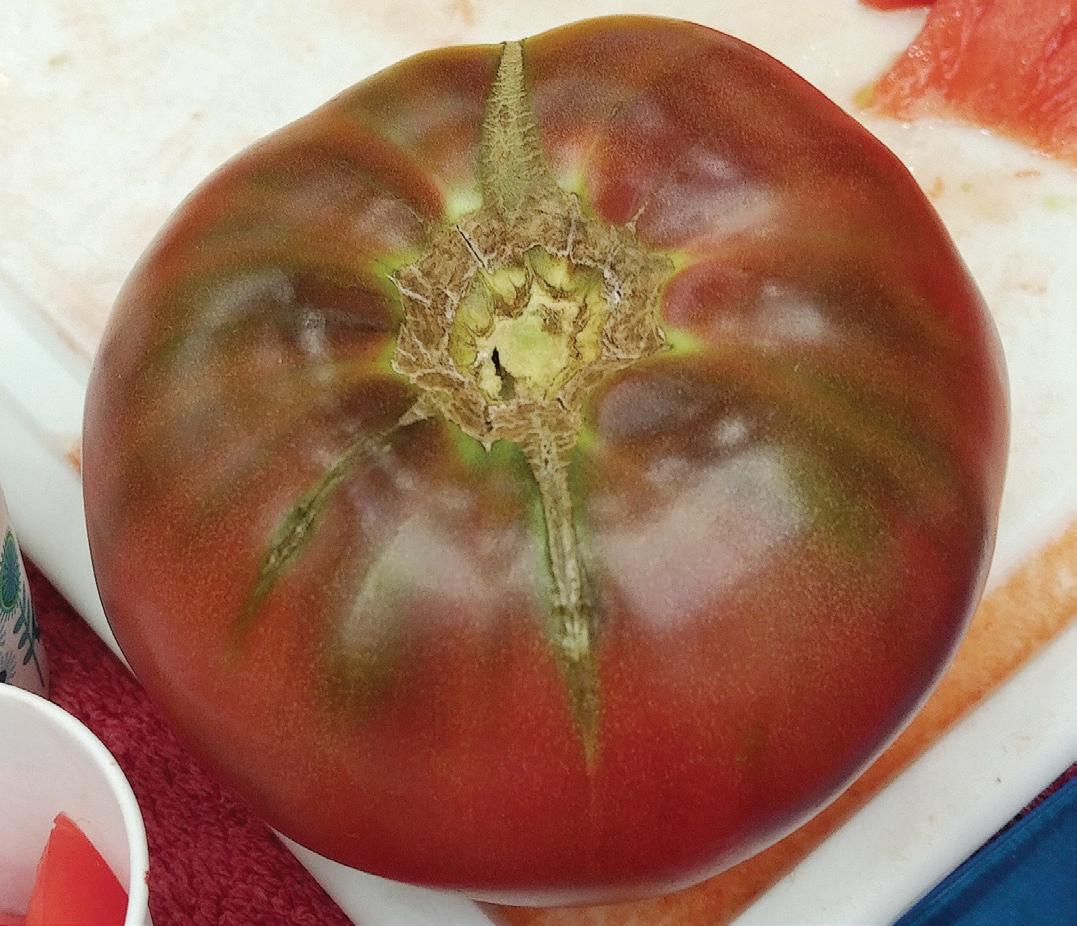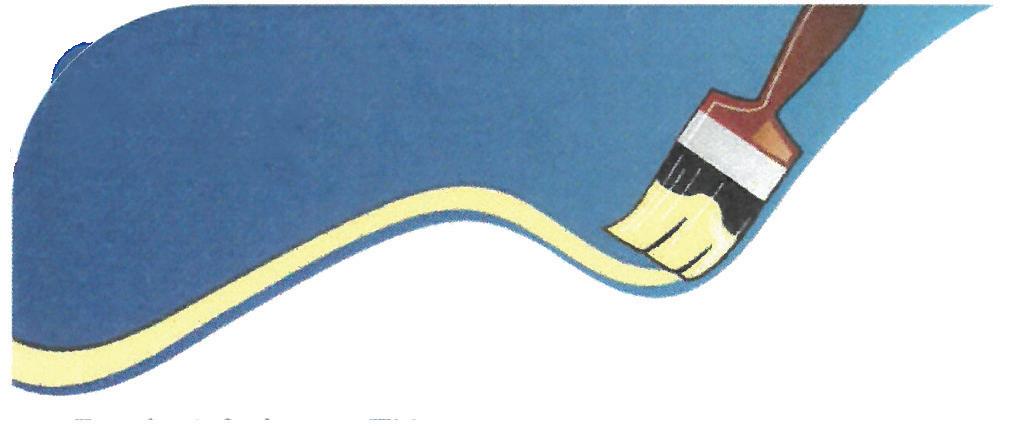
10 minute read
Growing tomatoes
25 Spring 2020 Growing tomatoes in four steps
By Beth McMahon
Advertisement
Tomatoes are the favored vegetable for growing at home. They aren’t difficult to grow either, provided you know how.
Step One: Pick the Best Spot
Tomatoes require eight to 10 hours of sunlight. They will grow if they get less, but the plants will be leggy and not bloom much.
Wind circulation isn’t something that is normally considered for a vegetable garden, but it’s important for getting tomatoes. Tomatoes need the wind to gently shake the flowers to allow them to pollinate.
If your tomato plants are in a location that is too sheltered, your production will likely be low.
Bumblebees can visit tomato flowers, but are unlikely to be a major pollination source.
Good soil can be hard to find but get your tomato plants started off right with a soil that is at least one foot deep (not counting caliche).
If you don’t have this, you can grow tomatoes in four- to five-gallon sized containers. Plant one plant per five-gallon container and
See TOMATOES ▶ 26 Ripe “Black Krim” heirloom tomato. — Photos courtesy Beth McMahon
Elizabeth McMahon is the Gillespie County Horticulture Agent. Questions and comments can be sent to elizabeth.mcmahon@ ag.tamu.edu.
O
Construction Inc. Serving the Hill Country Since 1982


If you are dedicated to creating a unique new or remodeled home, custom built to your specifications, you will want a home built or remodeled by Curl’s Construction, Inc.
We have been building custom homes using the latest in material technology applied with old German craftsmanship since 1982.
curlsconst@ctesc.net
Although homes are our specialty, we also do light commercial construction. Curl’s Construction, Inc. offers nothing less than perfection.
make sure it has many holes in the bottom to promote drainage.
If you’ve grown tomatoes before, don’t plant them in the same spot as you did last year, or where you planted your potatoes, peppers or eggplants. These plants are all related and can increase disease pressure for your tomatoes.
The deer are hungry and they like eating your tomatoes. If you’re planting your tomatoes into a garden, you will need to have deerproof fencing around it.
The deer may not be afraid to come up onto your porch. If you’ve had problems with them getting that close before, try using chicken wire to protect your containers.
It being the Texas Hill Country, don’t forget to have a water source nearby.
Step Two: Pick the Right Kind
There are more tomato varieties than one can imagine.
To narrow it down, figure out if you want a determinate or indeterminate tomato.
Determinate tomato plants are shorter and produce within a set time period.
Indeterminate tomatoes grow tall and produce a few tomatoes continually.
To narrow your variety selection further, determine if you would like to grow an heirloom, open pollinated, or hybrid tomato.
Heirlooms are special tomato varieties that have been saved

Curtis Staudt Construction
Quality Built Custom Homes Restoration & Remodel Over 41 Years Experience In Fredericksburg And The Hill Country 2585 White Oak Road•Fredericksburg 830-997-4729
throughout generations. They typically have unusual colors and different flavors but may not be very productive or as disease and pest resistant.
Open pollinated tomatoes are the same as heirlooms, they just haven’t been around long enough to be considered as such. Open pollinated varieties include many of our old field tomato varieties.
Hybrids are the result of two inbred tomato lines crossing. These typically have better production and disease and pest resistances, but the seed can be expensive and you can’t save it.
There are good varieties of these kinds that can be grown here in the Texas Hill Country.
If you’re looking for general purpose or tomatoes to slice and put on a sandwich, try heirlooms and/or open pollinated varieties such as “Cherokee Purple,” “Black Krim” or “Abe Lincoln.” Hybrids include “Celebrity,” “Big Beef,” “Valley Girl” and “Valley Cat.”
If looking for smaller tomatoes, such as grapes, cherries or pear shaped, try hybrids such as “Juliet,” “Sweet 100” or “Sun Gold.”
Heirlooms to try include “Yellow Pear” or “Vernissage Black.”
Cherry tomatoes are less likely to quit producing when the weather gets too hot.
Step Three: Treat it Right Planting
The risk of frost gradually decreases as April approaches.
You can plant earlier than April, and indeed, it’s commendable to do so because you’ll want your tomatoes to produce all they can

Painting, Repairs, Decorating and Wallpaper
Fredericksburg, TX

: 830-733-0750 : hillcountryfinishing@gmail.com : www.hillcountryfinishing.com
“An Artist Touch to Any Project.”
Lissa Denney / Artist, Craftsman



The Hill Country’s Oldest Seamless Raingutter Company • Workers Compensation • General Liability 2147 North US Hwy 87 • Fredericksburg • (830) 990-0068 • guttermanraingutter.com Water Collection Tanks Sales and Installation Galvanized • Stainless Steel • Plasic 20+ Colors • 100 Gallon up to 1500 Gallon
ExclusivE dealer for: 6 1/2” SEAMLESS Bear-Claw ™
Half-Round Gutters
6” seamless K-style Gutters also available
Copper, Galvalume Steel or 33 custom aluminum color choices. Member FREE ESTIMATES
Call for consultation.
before the heat of summer hits.
However, we have had late frosts before, so have a plan to protect your plants.
Tomatoes should be spaced two to four feet from each other. If you purchase lanky tall tomato plants, you can bury some of the stem.
Incorporate compost or slow release fertilizer at planting. Do not use a fast release fertilizer, because this may burn the roots.
After the first cluster of fruit sets, work in two to three tablespoons per plant of a high nitrogen quick release fertilizer.
Next year, to give yourself an advance start without worrying about the frost, purchase little square pots of tomatoes early, but transplant them into gallon sized pots. Then transplant these bigger plants into your garden after danger of frost.
Staking and Caging
Caging or trellising your tomato plants promotes air circulation and less disease.
Determinate type tomatoes do not get very tall, so a simple threeto four-foot cage will work. For indeterminate types, you need a tall cage, at least five feet, or trellis them.
I tie mine to cattle panels and then drape them over, but there are also ways to weave tomato plants between poles and ropes.
Tying an indeterminate tomato plant to a simple bamboo stake may not work, but a fence stay pounded into the ground may be enough.
Watering
To determine if you need to water or not, dig down six inches. Grab
See TOMATOES ▶ 28


Instead of cages, tying tomato plants to a cattle panel is an option.
some of the soil and form it into a ball.
If it leaves a wet outline on your hand when you squeeze, it doesn’t need water. If it’s cool to the touch but crumbles when you make a ball, you should water.
Water slowly and deeply, whether through drip irrigation or furrows dug into the ground around the plant or down the row.
Avoid overhead watering with a sprinkler because wet foliage can lead to disease.
If you’ve had issues with your tomatoes cracking, try putting a light mulch, such as pine needles, herbicide-free hay, or leaves on top of the soil around the plants.
Mulching can insure a more constant moisture flow which may help decrease cracking.
Shade Cloth
Some of the Master Gardeners that I know use shade cloth to great effect in growing their tomatoes.
I can certainly understand the benefits.
Row cover or shade cloth draped over your tomatoes creates a cooler climate, decreasing sunscald and helping to conserve moisture.
It may even decrease your chances of getting spider mites. Row covers permit a certain percentage of light. For tomatoes, try a 30-40% row cover.
Using a row cover is not the same as growing in an area with less than eight to 10 hours of sunlight.
Common Problems
Early in the season you may see blossom end rot. This is when the tomato has a large black spot on the bottom of the fruit.
This technically isn’t a disease, just an inability to move calcium properly in the plant. Wait until it gets warmer or stop watering daily, and the disease should correct itself.
Septoria leaf spot and early blight are different diseases, but both cause the tomato plant to defoliate from the bottom leaves upward.
Keep your plants off the ground, trim off leaves touching the soil, and if you start to see spots, spray a chlorothalonil fungicide such as Daconil or Bonide Fung-onil to treat these two diseases.
Hornworms are large caterpillars that can take out a small tomato plant in only a few days. The caterpillars look fierce, with a horn on their rump.
Don’t be fooled, these will not sting, though they may curl themselves threateningly.
Hornworms blend in and can be difficult to see, but if you see a lot of damage on a plant or do manage to spot them, pull them off and squish them or throw them to some chickens. Chickens love hornworms.
Sunscald can happen when the tomatoes don’t have enough foliage cover. You can’t fix the tomatoes already scalded but prevent damage to future ones by draping more foliage over the plant, using shade cloth or taking clean panty hose and bagging the fruit.
Spider mites are a difficult pest to control on tomatoes in home gardens. They produce webbing and their feeding on plants gives the leaves a stippled appearance, as if they were sandblasted. Some years and gardens can be more susceptible than others.

Oil sprays such as neem oil are labeled for spider mites, but by the time you have the mites, you’re likely to have the hot weather, too, and it will be too hot to spray unless it’s at night (which causes the neighbors to ask questions).
Use row covers or shade cloth on your tomatoes if this has been a historical problem, mulch your plants, and consider watering a bit more.
When the night temperatures rise above the middle 70’s, pollen shed in tomatoes can be disrupted, so your regular tomato plants may not set as much fruit as normal, if any.
Try shade cloth to keep the plants going longer or grow cherry tomatoes instead.
Step Four: Harvesting
In a perfect world you would be able to harvest your tomatoes at peak ripeness.
It is not a perfect world.
Likely some bird, probably a cardinal or mockingbird, is going to come along and peck your perfect tomato before it’s fully ripe.
If it’s not the birds, it’s the diseases or insects.
Thankfully tomatoes can be hand ripened on counters.
Tomato flowers need wind to form little tomatoes.

Simply pick at first blush of color, then allow your tomatoes to finish ripening to the desired degree out of the sun at room temperature. Do not refrigerate. - - - Tomato transplants have been selling very well this year, and I suspect there will be many first-time growers.
If you encounter a problem that wasn’t written about here, feel free to send me an email at Elizabeth.mcmahon@ag.tamu. edu . Good luck!
MANITZAS AUDIO VISUAL, LLC
Pre-Wires • Televisions • Mounts • Speakers











